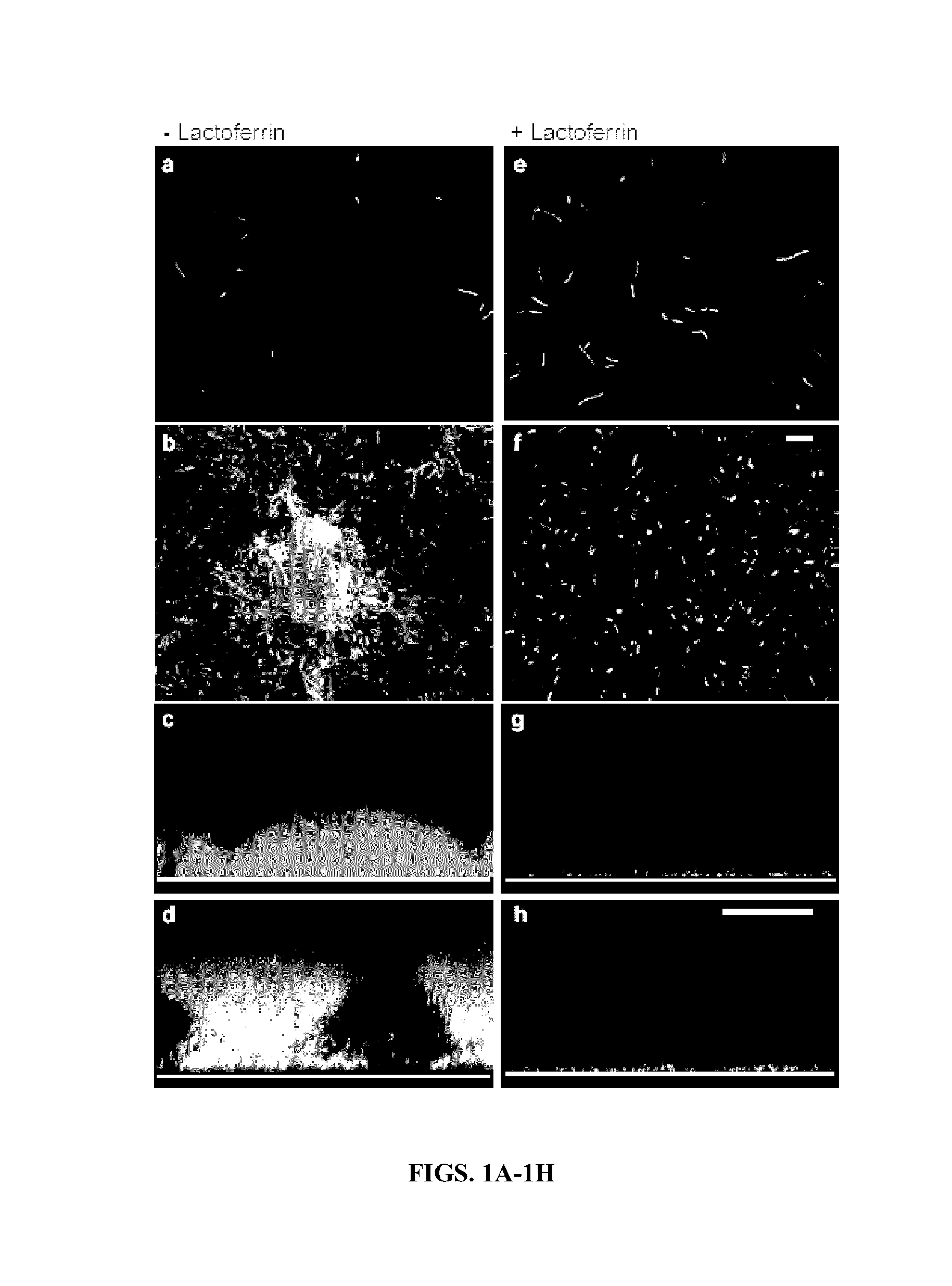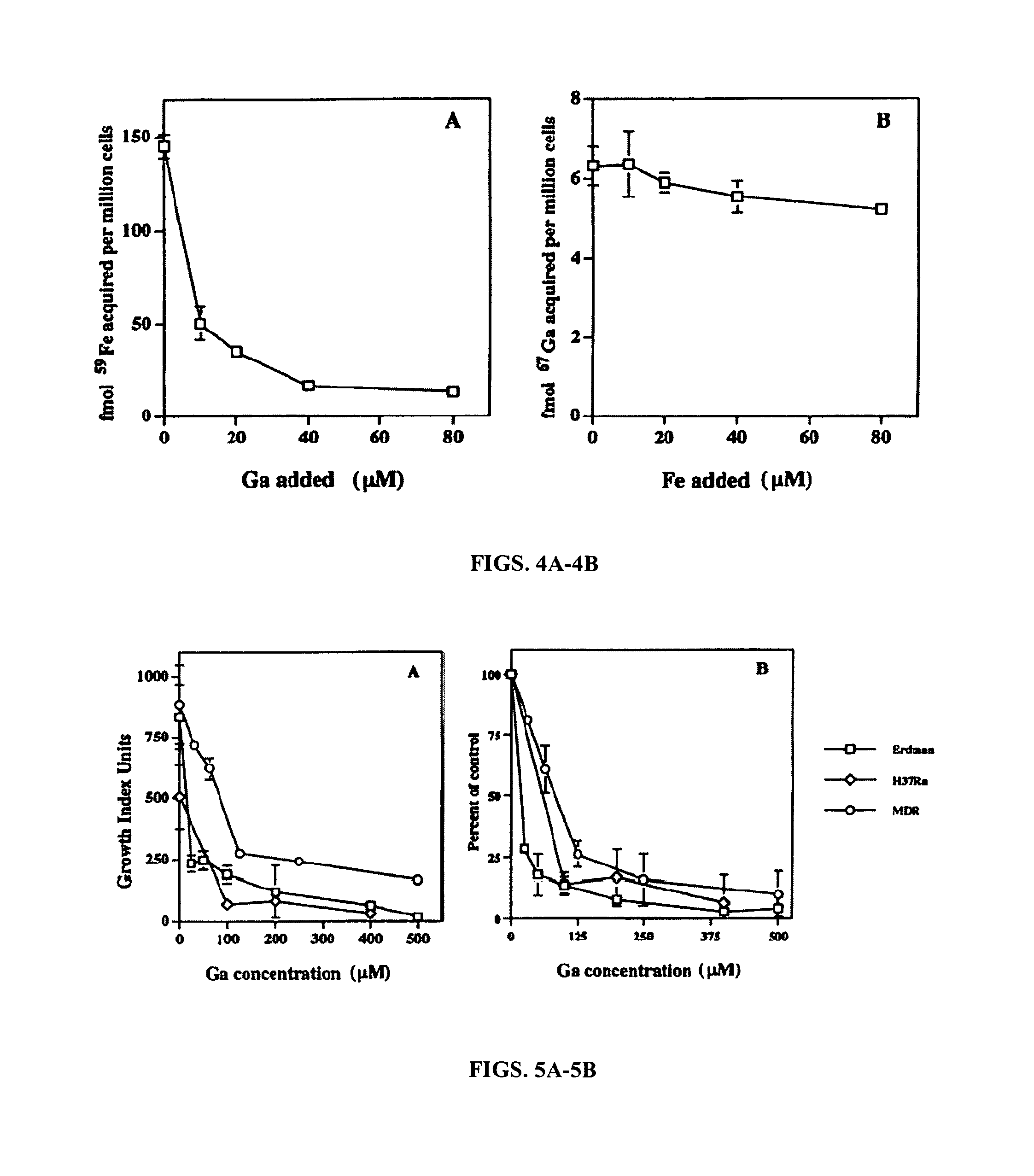Gallium inhibits biofilm formation
a technology of gallium and biofilm, applied in the field of medical and industrial, can solve the problems of increasing the risk of nosocomial pneumonia, nocomial infection, and infection such as nosocomial infection, and achieve the effects of preventing the initiation of infection, and preventing or inhibiting biofilm growth formation
- Summary
- Abstract
- Description
- Claims
- Application Information
AI Technical Summary
Benefits of technology
Problems solved by technology
Method used
Image
Examples
example 1
Fe Availability and P. aeruginosa Biofilm Growth Formation
[0073]It is well known in the art that P. aeruginosa forms biofilms via a carefully regulated process. Biofilm formation has been shown it to be regulated by the P. aeruginosa quorum sensing system (Davis et al., 1998). Previous work by the inventors demonstrated that Fe availability plays a critical role in the establishment phase of a biofilm by P. aeruginosa. Additionally, the inventors have shown that gallium can disrupt bacterial Fe-dependent metabolism. Gallium, at sub-inhibitory concentrations was found to prevent biofilm formation by P. aeruginosa in vitro.
[0074]Preliminary studies demonstrated that concentrations of the Fe-binding protein lactoferrin (LF) that did not alter P. aeruginosa growth profoundly inhibited biofilm formation by P. aeruginosa as determined microscopically in a previously developed flow cell model of biofilm formation (Singh et al., 2002; FIGS. 1A-1H). This effect was reversed by the presence o...
example 2
Antimicrobial Activity of Gallium Against Pathogenic Mycobacteria
[0077]The inventors have previously shown that gallium inhibits the growth of M. tuberculosis and Mycobacterium Avium Complex (MAC) extracellularly and within human macrophages (Olakanmi et al., 2000). Mycobacteria were incubated in BACTEC 12B broth culture bottles in the absence or presence of Ga(NO3)3. The BACTEC system monitors mycobacterial growth as release of 14CO2 generated during bacterial incorporation of [14C] palmitate into the mycobacterial cell wall. A concentration-dependent growth inhibition of each mycobacterial strain was observed with Ga(NO3)3 (Olakanmi et al., 2000). The BACTEC system was employed because of its sensitivity and speed. However, its medium contains up to 1.6 mM Fe (ferrozine assay). In comparison, the concentration of extracellular Fe in vivo is 5-10 μM. When Erdman M. tuberculosis was exposed to gallium in 7H9 broth made without Fe supplementation (2 μM Fe), as expected, significant ...
example 3
Antimicrobial Activity of Gallium Against Pathogenic Mycobacteria within Macrophages
[0079]The critical site of growth of mycobacteria in vivo is within host macrophages. Gas is found to inhibit M. tuberculosis growth within these cells (Olakanmi et al., 2000; FIG. 5A). NaNO3 had no effect on mycobacterial growth, confirming that gallium was responsible. Although mycobacterial growth was inhibited up to 50% at 24 hr, more striking inhibition (>70%) was observed after 48 hrs (FIG. 5B). This may relate to the time required for uptake and trafficking of gallium into the macrophage and then to the bacterium. The effect of gallium was not due to loss of the monocyte-derived macrophage (MDM) monolayer. In fact, gallium prevented loss of monolayers over time due to M. tuberculosis multiplication.
[0080]When Ga(NO3)3 is administered intravenously, a majority of the gallium is chelated by serum transferrin (TF) (Seligman et al., 1992; Bernstein, 1998). Ga-TF was found to be as effective as Ga(...
PUM
| Property | Measurement | Unit |
|---|---|---|
| OD | aaaaa | aaaaa |
| concentration | aaaaa | aaaaa |
| antibiotic resistance | aaaaa | aaaaa |
Abstract
Description
Claims
Application Information
 Login to View More
Login to View More - R&D
- Intellectual Property
- Life Sciences
- Materials
- Tech Scout
- Unparalleled Data Quality
- Higher Quality Content
- 60% Fewer Hallucinations
Browse by: Latest US Patents, China's latest patents, Technical Efficacy Thesaurus, Application Domain, Technology Topic, Popular Technical Reports.
© 2025 PatSnap. All rights reserved.Legal|Privacy policy|Modern Slavery Act Transparency Statement|Sitemap|About US| Contact US: help@patsnap.com



